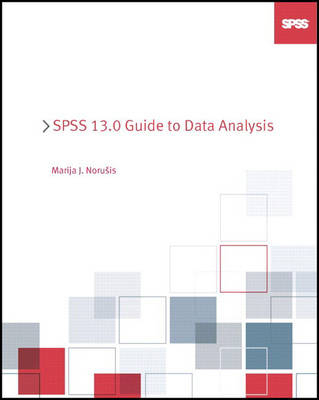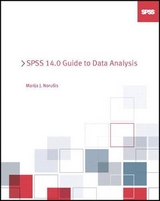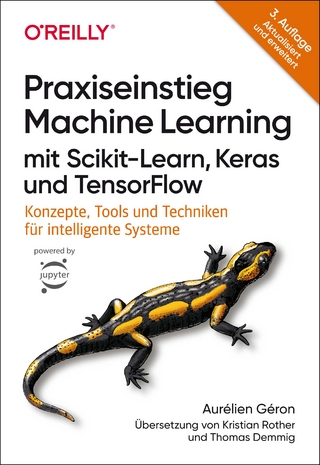
SPSS 13.0 Guide to Data Analysis
Pearson (Verlag)
978-0-13-186535-8 (ISBN)
- Titel erscheint in neuer Auflage
- Artikel merken
I Getting Started with SPSS
1. Introduction
About This Book. Getting Started with SPSS. Describing Data. Testing Hypotheses. Examining Relationships. Let’s Get Started.
2. An Introductory Tour of SPSS
Starting SPSS. Help Is Always at Hand. Copying the Data Files. Opening a Data File. Statistical Procedures. The Viewer Window. Viewer Objects. The Data Editor Window. Entering Non-Numeric Data. Clearing the Data Editor without Saving Changes. The SPSS Online Tutorial. The SPSS Toolbar. The SPSS Help System. Contextual Help. What’s Next?
3. Sources of Data
Know Your Data. Survey Data. Asking the Question. Measuring Time. Selecting Participants. Selecting a Sample. General Social Survey. Random-Digit Dialing. Internet Surveys. Designing Experiments. Random Assignment. Minimizing Bias. Summary. What’s Next? Exercises.
II Describing Data
1. Counting Responses
Describing Variables. A Simple Frequency Table. Sorting Frequency Tables. Pie Charts. Bar Charts. Summarizing Internet Time. Histograms. Mode and Median. Percentiles. Summary. What’s Next? How to Obtain a Frequency Table. Format: Appearance of the Frequency Table. Statistics: Univariate Statistics. Charts: Bar Charts, Pie Charts, and Histograms. Exercises.
2. Computing Descriptive Statistics
Summarizing Data. Scales of Measurement. Mode, Median, and Arithmetic Average. Comparing Mean and Median. Summarizing Time Spent Online. Measures of Variability. Range. Variance and Standard Deviation. The Coefficient of Variation. Standard Scores. Summary. What’s Next? How to Obtain Univariate Descriptive Statistics. Options: Choosing Statistics and Sorting Variables. Exercises.
3. Comparing Groups
Age, Education, and Internet Use. Plotting Means. Layers: Defining Subgroups by More than One Variable. Summary. What’s Next? How to Obtain Subgroup Means. Layers: Defining Subgroups by More than One Variable. Options: Additional Statistics and Display of Labels. Exercises.
4. Looking at Distributions
Marathon Completion Times. Age and Gender. Marathon Times for Mature Runners. Summary. What’s Next? How to Explore Distributions. Explore Statistics. Graphical Displays. Options. Exercises.
5. Counting Responses for Combinations of Variables
Library Use and Education. Row and Column Percentages. Bar Charts. Adding Control Variables. Library Use and the Internet. Summary. What’s Next?. How to Obtain a Crosstabulation. Layers: Three or More Variables at Once. Cells: Percentages, Expected Counts, and Residuals. Bivariate Statistics. Format: Adjusting the Table Format. Exercises.
6. Plotting Data
Examining Population Indicators. Simple Scatterplots. Scatterplot Matrices. Overlay Plots. Three-Dimensional Plots. Identifying Unusual Points. Rotating 3-D Scatterplots. Summary. What’s Next? How to Obtain a Scatterplot. Obtaining a Simple Scatterplot. Obtaining an Overlay Scatterplot. Obtaining a Scatterplot Matrix. Obtaining a 3-D Scatterplot. Editing a Scatterplot. Exercises.
III Testing Hypotheses
1. Evaluating Results from Samples
From Sample to Population. A Computer Model. The Effect of Sample Size. The Binomial Test. Summary. What’s Next? Exercises.
2. The Normal Distribution
The Normal Distribution. Samples from a Normal Distribution. Means from a Normal Population. Are the Sample Results Unlikely? Testing a Hypothesis. Means from Non-Normal Distributions. Means from a Uniform Distribution. Summary. What’s Next? Exercises.
3. Testing a Hypothesis about a Single Mean
Examining the Data. The T Distribution. Calculating the T Statistic. Confidence Intervals. Other Confidence Levels. Confidence Interval for a Difference. Confidence Intervals and Hypothesis Tests. Null Hypotheses and Alternative Hypotheses. Rejecting the Null Hypothesis. Summary. What’s Next? How to Obtain a One-Sample T Test. Options: Confidence Level and Missing Data. Exercises.
4. Testing a Hypothesis about Two Related Means
Marathon Runners in Paired Designs. Looking at Differences. Is the Mean Difference Zero? Two Approaches. The Paired-Samples T Test. Are You Positive? Some Possible Problems. Examining Normality. Summary. What’s Next? How to Obtain a Paired-Samples T Test. Options: Confidence Level and Missing Data. Exercises.
5. Testing a Hypothesis about Two Independent Means
Examining Television Viewing. Distribution of Differences. Standard Error of the Mean Difference. Computing the T Statistic. Output from the Two-Independent-Samples T Test. Confidence Intervals for the Mean Difference. Testing the Equality of Variances. Effect of Outliers. Introducing Education. Can You Prove the Null Hypothesis? Interpreting the Observed Significance Level. Power. Monitoring Death Rates. Does Significant Mean Important? Summary. What’s Next? How to Obtain an Independent-Samples T Test. Define Groups: Specifying the Subgroups. Options: Confidence Level and Missing Data. Exercises.
6. One-Way Analysis of Variance
Hours in a Work Week. Describing the Data. Confidence Intervals for the Group Means. Testing the Null Hypothesis. Assumptions Needed for Analysis of Variance. Analyzing the Variability. Comparing the Two Estimates of Variability. The Analysis-of-Variance Table. Multiple Comparison Procedures. Television Viewing, Education, and Internet Use. Summary. What’s Next? How to Obtain a One-Way Analysis of Variance. Post Hoc Multiple Comparisons: Finding the Difference. Options: Statistics and Missing Data. Exercises.
7. Two-Way Analysis of Variance
The Design. Examining the Data. Testing Hypotheses. Degree and Gender Interaction. Necessary Assumptions. Analysis-of-Variance Table. Testing the Degree-by-Gender Interaction. Testing the Main Effects. Removing the Interaction Effect. Where Are the Differences? Multiple Comparison Results. Checking Assumptions. A Look at Television. Extensions. Summary. What’s Next? How to Obtain a GLM Univariate Analysis. GLM Univariate: Model. GLM Univariate: Plots. GLM Univariate: Post Hoc. GLM Univariate: Options. GLM Univariate: Save. Exercises.
8. Comparing Observed and Expected Counts
Freedom or Manners? Observed and Expected Counts. The Chi-Square Statistic. A Larger Table. Does College Open Doors? A One-Sample Chi-Square Test. Power Concerns. Summary. What’s Next?. Exercises.
9. Nonparametric Tests
Nonparametric Tests for Paired Data. Sign Test. Wilcoxon Test. Who’s Sending E-mail? Mann-Whitney Test. Kruskal-Wallis Test. Friedman Test. Summary. How to Obtain Nonparametric Tests. Chi-Square Test. Binomial Test. Two-Independent-Samples Tests. Several-Independent-Samples Tests. Two-Related-Samples Tests. Several-Related-Samples Tests. Options: Descriptive Statistics and Missing Values. Exercises.
IV Examining Relationships
1. Measuring Association
Components of the Justice System. Proportional Reduction in Error. Measures of Association for Ordinal Variables. Concordant and Discordant Pairs. Measures Based on Concordant and Discordant Pairs. Evaluating the Components. Measuring Agreement. Correlation-Based Measures. Measures Based on the Chi-Square Statistic. Summary. What’s Next? Exercises.
2. Linear Regression and Correlation
Life Expectancy and Birthrate. Choosing the “Best” Line. Calculating the Least-Squares Line. Calculating Predicted Values and Residuals. Determining How Well the Line Fits. Explaining Variability. Some Warnings. Summary. What’s Next? How to Obtain a Linear Regression. Statistics: Further Information on the Model. Residual Plots: Basic Residual Analysis. Linear Regression Save: Creating New Variables. Linear Regression Options. Exercises.
3. Testing Regression Hypotheses
The Population Regression Line. Assumptions Needed for Testing Hypotheses. Testing Hypotheses. Testing that the Slope Is Zero. Confidence Intervals for the Slope and Intercept. Predicting Life Expectancy. Predicting Means and Individual Observations. Standard Error of the Predicted Mean. Confidence Intervals for the Predicted Means. Prediction Intervals for Individual Cases. Summary. What’s Next? How to Obtain a Bivariate Correlation. Options: Additional Statistics and Missing Data. How to Obtain a Partial Correlation. Options: Additional Statistics and Missing Data. Exercises.
4. Analyzing Residuals
Residuals. Standardized Residuals. Studentized Residuals. Checking for Normality. Checking for Constant Variance. Checking Linearity. Checking Independence. A Final Comment on Assumptions. Looking for Influential Points. Studentized Deleted Residuals. Summary. What’s Next? Exercises.
5. Building Multiple Regression Models
Predicting Life Expectancy. The Model. Assumptions for Multiple Regression. Examining the Variables. Looking at How Well the Model Fits. Examining the Coefficients. Interpreting the Partial Regression Coefficients. Changing the Model. Partial Correlation Coefficients. Tolerance and Multicollinearity. Beta Coefficients. Building a Regression Model. Methods for Selecting Variables. Summary. What’s Next? How to Obtain a Multiple Linear Regression. Options: Variable Selection Criteria. Exercises.
6. Multiple Regression Diagnostics
Examining Normality. Scatterplots of Residuals. Leverage. Changes in the Coefficients. Cook’s Distance. Plots against Independent Variables. Partial Regression Plot. Why Bother? Summary. Exercises.
V Appendices
Obtaining Charts in SPSS
Overview. Creating Bar Charts. Creating a Chart Comparing Groups of Cases. Data Summary Options. Creating a Chart Comparing Several Variables. Changing the Summary Statistic. Options in Creating Charts. Modifying Charts. Modifying Chart Options. Hints on Editing Charts. Saving Chart Files. Line and Area Charts. Pie Charts. Boxplots. Case Labels. Error Bar Charts. Histograms. Normal Probability Plots.
Transforming and Selecting Data
Data Transformations. Transformations at a Glance. Saving Changes. Delaying Processing of Transformations. Recoding Values. Computing Variables. The Calculator Pad. Automatic Recoding. Conditional Transformations. Case Selection. Temporary or Permanent Selection. Other Selection Methods.
The T Distribution
Areas under the NormalCurve
Descriptions of Data Files
Answers to Selected Exercises
Bibliography
Index
| Erscheint lt. Verlag | 19.5.2005 |
|---|---|
| Sprache | englisch |
| Maße | 189 x 229 mm |
| Gewicht | 992 g |
| Themenwelt | Informatik ► Datenbanken ► Data Warehouse / Data Mining |
| Mathematik / Informatik ► Mathematik ► Computerprogramme / Computeralgebra | |
| ISBN-10 | 0-13-186535-8 / 0131865358 |
| ISBN-13 | 978-0-13-186535-8 / 9780131865358 |
| Zustand | Neuware |
| Haben Sie eine Frage zum Produkt? |
aus dem Bereich



